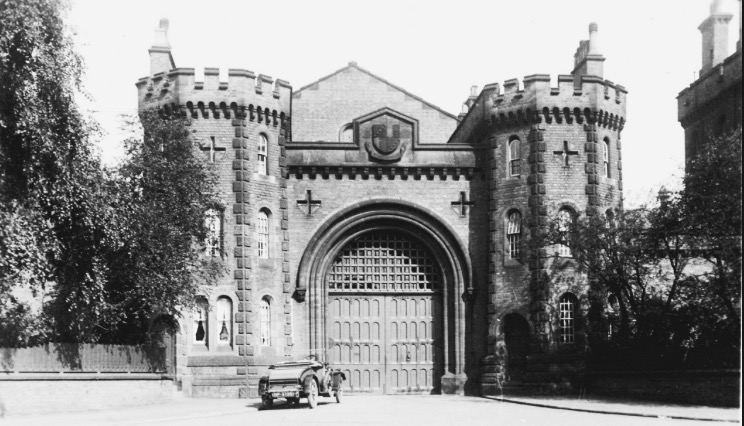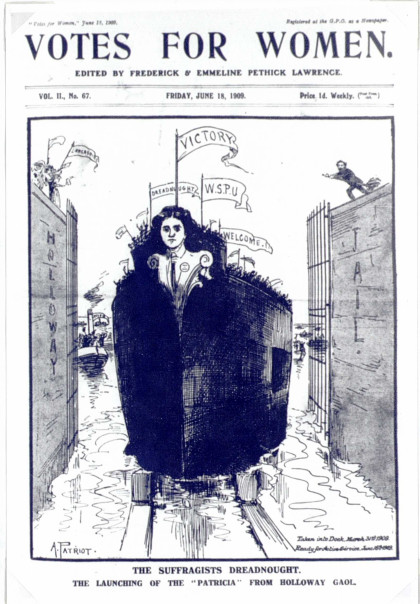|
Evaline Hilda Burkitt
Evaline Hilda Burkitt (19 July 1876 – 7 March 1955) was a British suffragette and member of the Women's Social and Political Union (WSPU). A militant activist for Women's suffrage, women's rights, she went on hunger strike in prison and was the first suffragette to be Force-feeding, forcibly-fed. Between 1909 and 1914 she was force-fed 292 times and was the last woman to be so treated in HM Prison Holloway, Holloway Prison. She was a recipient of the WSPU's Hunger Strike Medal. Life and Activism Evaline Hilda Burkitt was born in Wolverhampton in 1876, the fifth of nine children born to Laura ''née'' Clews (1843–1909) and Reuben Lancelot Burkitt (1847–1928). The children were well educated, including the girls. Burkitt was interested in reading, needlework and gardening. She lived with her wealthy grandparents Clarissa and Charles Burkitt until she was 25 years old, and then rejoined her family, who had moved to Birmingham. She moved in with her elder sister Christobel ... [...More Info...] [...Related Items...] OR: [Wikipedia] [Google] [Baidu] |
Bingley Hall
Bingley Hall in Birmingham was the first purpose-built exhibition hall in Great Britain. It was built in 1850 and burned down in 1984. The International Convention Centre now stands on the site. Precursor The precursor of Bingley Hall was an " Exhibition of the Manufactures of Birmingham and the Midland Counties" in a temporary wooden hall built in the grounds of, and attached to, Bingley House on Broad Street in central Birmingham (once the home of banker Charles Lloyd, and visited by Samuel Taylor Coleridge) and opened on 3 September 1849 for visitors to the Birmingham Triennial Music Festival. This exhibition was visited by Charles Darwin, and also on 12 November by Prince Albert and may have contributed to his ideas for the Great Exhibition of 1851 at the Crystal Palace. History Bingley House was built about 1760 as Byngas Hall, but was shown on local maps as Byngas Hall as early as 1553, and was the home of James Farmer, whose daughter Mary married Charles Lloyd. The h ... [...More Info...] [...Related Items...] OR: [Wikipedia] [Google] [Baidu] |
Prisoners (Temporary Discharge For Ill Health) Act 1913
The Prisoners (Temporary Discharge for Ill Health) Act, commonly referred to as the Cat and Mouse Act, was an Act of Parliament passed in Britain under H. H. Asquith's Liberal government in 1913. Some members of the Women's Social and Political Union (WSPU, commonly referred to as suffragettes) had been imprisoned for acts of vandalism in support of women's suffrage. In protest at being imprisoned, some of the suffragettes undertook hunger strikes. The hunger strikers were force-fed by the prison staff, leading to a public outcry. The act was a response to the protestations. It allowed the prisoners to be released on licence as soon as the hunger strike affected their health; they then had a predetermined period of time in which to recover after which they were rearrested and taken back to prison to serve out the rest of their sentence. Conditions could be placed on the prisoner during the time of their release. One effect of the act was to make hunger strikes technically legal. ... [...More Info...] [...Related Items...] OR: [Wikipedia] [Google] [Baidu] |
Britannia Pier Great Yarmouth 1914
Britannia () is the national personification of Britain as a helmeted female warrior holding a trident and shield. An image first used in classical antiquity, the Latin ''Britannia'' was the name variously applied to the British Isles, Great Britain, and the Roman province of Britain during the Roman Empire. Typically depicted reclining or seated with spear and shield since appearing thus on Roman coins of the 2nd century AD, the classical national allegory was revived in the early modern period. On coins of the pound sterling issued by Charles II of England, Scotland, and Ireland, Britannia appears with her shield bearing the Union Flag. To symbolise the Royal Navy's victories, Britannia's spear became the characteristic trident in 1797, and a helmet was added to the coinage in 1825. By the 1st century BC, Britannia replaced Albion as the prevalent Latin name for the island of Great Britain. After the Roman conquest in 43 AD, ''Britannia'' also came to refer to the Roman pro ... [...More Info...] [...Related Items...] OR: [Wikipedia] [Google] [Baidu] |
Stoke-on-Trent
Stoke-on-Trent (often abbreviated to Stoke) is a city and unitary authority area in Staffordshire, England, with an area of . In 2019, the city had an estimated population of 256,375. It is the largest settlement in Staffordshire and is surrounded by the towns of Newcastle-under-Lyme, Alsager, Kidsgrove, Biddulph and Stone, which form a conurbation around the city. Stoke is polycentric, having been formed by the federation of six towns in 1910. It took its name from Stoke-upon-Trent where the main centre of government and the principal railway station in the district were located. Hanley is the primary commercial centre; the other four towns which form the city are Burslem, Tunstall, Longton and Fenton. Stoke-on-Trent is the home of the pottery industry in England and known as The Potteries. Formerly a primarily industrial conurbation, it is now a centre for service industries and distribution centres. History Toponymy and etymology The name ''Stoke'' is taken from the t ... [...More Info...] [...Related Items...] OR: [Wikipedia] [Google] [Baidu] |
Clara Giveen
Clara Elizabeth Giveen, also known as Betty Giveen, later Mrs Betty Brewster (1887–1967) was a British suffragette. She was known for an arson attack on the grandstand at the Hurst Park Racecourse in 1913, and for her "cat and mouse" imprisonment. Biography Giveen was born in 1887 in Coleraine, County Londonderry, Ireland. According to her National Portrait Gallery biography, she was radicalised by witnessing the brutal treatment of women at the hands of the police at the 1910 Black Friday demonstration outside the Palace of Westminster, and joined the Women's Social and Political Union (WSPU). She took part in a number of WSPU actions, including a 1910 demonstration in Downing Street where she was arrested for obstruction but not charged. She was arrested again on 21 November 1911 and imprisoned for five days for breaking windows at a local government board office. She was once again arrested and imprisoned, this time for four months, along with Violet Aitken, for window-b ... [...More Info...] [...Related Items...] OR: [Wikipedia] [Google] [Baidu] |
Leeds
Leeds () is a City status in the United Kingdom, city and the administrative centre of the City of Leeds district in West Yorkshire, England. It is built around the River Aire and is in the eastern foothills of the Pennines. It is also the third-largest settlement (by population) in England, after London and Birmingham. The city was a small manorial borough in the 13th century and a market town in the 16th century. It expanded by becoming a major production centre, including of carbonated water where it was invented in the 1760s, and trading centre (mainly with wool) for the 17th and 18th centuries. It was a major mill town during the Industrial Revolution. It was also known for its flax industry, Foundry, iron foundries, engineering and printing, as well as shopping, with several surviving Victorian era arcades, such as Leeds Kirkgate Market, Kirkgate Market. City status was awarded in 1893, a populous urban centre formed in the following century which absorbed surrounding vi ... [...More Info...] [...Related Items...] OR: [Wikipedia] [Google] [Baidu] |
Patricia Woodlock
Patricia Woodlock (born Mary Winifred Woodlock; 25 October 1873 – after 1930) was a British artist and suffragette who was imprisoned seven times, including serving the longest suffragette prison sentence in 1908 (solitary confinement for three months); she was awarded a Women's Social and Political Union (WSPU) Hunger Strike Medal ''for Valour''. Her harsh sentence caused outrage among supporters and inspired others to join the protests. Her release was celebrated in Liverpool and London and drawn as a dreadnought warship, on the cover of the WSPU ''Votes for Women'' newsletter. Early life She was born Mary Winifred Woodlock in 1873 to an Irish socialist father David Woodlock, originally from Tipperary, who was also an artist, and his wife, Mary Teresa ( Martin). Known as "Patricia", she had three younger siblings: a decade younger sister, Evangeline; an eight years younger brother, Charles; and a two years younger brother, David Sarsfield Woodlock. Charles Woodlock report ... [...More Info...] [...Related Items...] OR: [Wikipedia] [Google] [Baidu] |
Laetitia Withall
Laetitia Withall (30 August 1881 – 11 March 1963) was an Australian-born poet, author and militant suffragette who campaigned in the United Kingdom for the Women's Social and Political Union (WSPU) under the name Leslie Hall. On her imprisonment she went on hunger strike and was force-fed for which she received the Hunger Strike Medal from the Women's Social and Political Union (WSPU). This medal is now in the collection of the National Library of Australia.Hunger strike medal presented to Letitia Withall by the Women's Social & Political Union (1913) - Online Collection |
Ellen Barnwell
Ellen is a female given name, a diminutive of Elizabeth, Eleanor, Elena and Helen. Ellen was the 609th most popular name in the U.S. and the 17th in Sweden in 2004. People named Ellen include: *Ellen Adarna (born 1988), Filipino actress *Ellen Alaküla (1927–2011), Estonian actress *Ellen Palmer Allerton (1835–1893), American poet *Ellen Allien (born 1969), German electronic musician and music producer *Ellen Anckarsvärd (1833-1898), Swedish feminist *Ellen Andersen (1898–1989), Danish museum curator *Ellen Anderson (born 1959), American politician *Ellen Auerbach (1906–2004), German-born American photographer *Ellen Baake (born 1961), German mathematical biologist *Ellen S. Baker (born 1953), American physician and astronaut *Ellen Barkin (born 1954), American actress *Ellen Bass (born 1947), American poet and author *Ellen A. Dayton Blair (1837–1926), social reformer and art teacher *Ellen Bontje (born 1958), Dutch equestrian *Ellen Burka (1921–2016), Dutch and C ... [...More Info...] [...Related Items...] OR: [Wikipedia] [Google] [Baidu] |
Laura Ainsworth
Laura Frances Ainsworth (1885 – 1958) was a British teacher and suffragette. She was employed by the Women's Social and Political Union and was one of the first suffragettes to be force-fed. She left the WSPU in 1912 in protest at the ejection of the Pethick-Lawrences, but continued to work for women's suffrage. Life Ainsworth was born in Blything in Suffolk in 1885, and she was brought up in Salisbury. She became a teacher but decided in 1909 to become a full time worker for the Women's Social and Political Union (WSPU) in 1909. Ainsworth was drafted to co-ordinate WSPU activities in the Midlands with Gladice Keevil. She was involved in the protest on 17 September 1909 when Charlotte Marsh, Mary Leigh and Patricia Woodlock climbed onto the roof of Bingley Hall in Birmingham. They were protesting at women being excluded from a political meeting where the British Prime Minister Asquith was giving a speech. Marsh , Leigh and Woodlock threw roof tiles which they levered up ... [...More Info...] [...Related Items...] OR: [Wikipedia] [Google] [Baidu] |
Charlotte Marsh
Charlotte Augusta Leopoldine Marsh (3 March 1887 – 21 April 1961), known as Charlie Marsh, was a militant British suffragette. She was a paid organiser of the Women's Social and Political Union and is one of the first women to be force fed during one of several terms of imprisonment for militant protest. She was chauffeur and mechanic to David Lloyd George during the First World War. Early life Marsh was born on 3 March 1887 in Alnmouth, near Newcastle, to Ellen (née Hall) (1863–1942) and Arthur Hardwick Marsh, a noted watercolourist residing at Prudhoe Tower. She had two older half sisters Margaret Hannah Phillis Marsh (1877–1931) and Phillis Clara Sylvia Marsh (1877–1965) from her father's first marriage to Juliana Phillis Glover (1839–1878) and four full sisters Nellie Wellesley Marsh (1885–1964); Dorothy Hale Marsh (1890–); Margaret Marsh (1892–) and Lois Marsh (1895–1963). Charlotte Marsh was educated locally at St Margaret's School and then at Roseneath ... [...More Info...] [...Related Items...] OR: [Wikipedia] [Google] [Baidu] |





.jpg)

.jpeg)